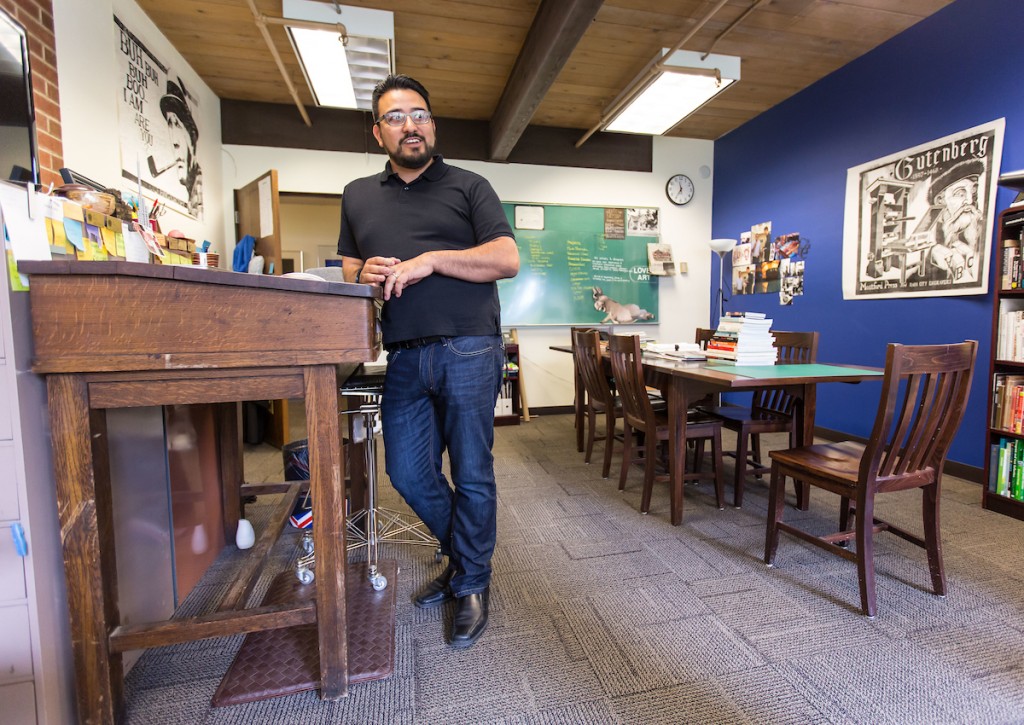Notes on Design-Centered Innovation at Pacific Lutheran University
By Michael Halvorson.
Design has become an integral component of the innovation process. Leading businesses such as Amazon, Apple, Nike, Disney, Dyson, and Airbnb are all recognized for their award-winning designs that strive to communicate the benefits of products to users and meet actual customer needs. The business world is replete with calls for design-centered innovation.
But, how do you learn design principles, and how do you use them to pursue new opportunities?
At Pacific Lutheran University, I sat down to find out with Jp Avila, Associate Professor of Art & Design and a co-founder of PLU’s Innovation Studies program. Avila received his M.F.A. in Visual Communication from the School of the Art Institute of Chicago, and he has taught Design at PLU since 2004. He is legendary on campus for both his passion for student learning and also his knack for teaching design principles to all students, including those lucky enough to be Design majors in the B.F.A. program.
Avila’s influence on PLU’s Innovation Studies program is significant. Because of his guidance, all students working toward the Innovation Studies minor must develop essential skills in either Communications or Design, in addition to the essential coursework that they take in business, economics, history, and ethics.
A Space for Design
Joining us in Avila’s expansive office—a space brimming with books, sketches, models, posters, and art boards—are two of Jp’s current students studying design, Janelle Brockman and Mackenzie Cooper.
Janelle is a sophomore Business major who has come to love design after taking ARTD 110 (Graphic Design 1) with Jp, and she is eager to integrate her new skills into her major and career plans. Janelle is curious about the Innovation Studies minor, too, and realized during our conversation that she already had three of the courses required for the program—BUSA 201 (Intro to Business), ECON 101 (Principles of Microeconomics), and now ARTD 110 (Graphic Design I).
Joining Janelle is Mackenzie Cooper, a senior Communications major at PLU. Mackenzie is experienced with writing and public relations but new to design. She has appreciated the technical skills with Adobe Illustrator that she picked up in this class, as well as the team-and project-focused curriculum.
Not only do Art & Design students work on numerous design projects in this class, but they also discuss (and defend) their concepts as they create them with peers and faculty members.
Professor Avila took some time to describe the innovation and design principles that students learn in his Graphic Design course. “In design, we take content that people may be familiar with and combine it with functional or aesthetic concepts that will resonate with an audience.” He continued:
“Essentially, design allows a person to dive deeply into the user’s experience of a product, and ideally it provides something of value to a customer or a client. What we stress in our introductory design course, in addition to software and other technical skills, is listening to the feedback of clients and being aware of the audience’s needs.”
Connecting Design to Message
As a demonstration of Jp’s point, Janelle and Mackenzie showed me some of their recent designs and asked me for my feedback, listening intently to my reactions and explaining their design choices. The project that they were working on required them to develop a promotional advertisement in five different formats for the Benson Lecture in Business and Economic History that PLU held on campus in Fall of 2017.
The lecturer was Brad Tilden, the CEO of Alaska Airlines, and all the design students in the class were required to attend the event. Their assignment was to create a group of print and digital marketing materials that would advertise the event and capture in some way the spirit of Mr. Tilden’s talk. Obviously, the project was extremely practical and useful—just what a student would want to learn as they prepare to be on a team that is marketing a new product or idea.
Keeping with the times, the students were asked to create a large-format poster, a flyer, a postcard mailer, an electronic (HTML) email banner, and a smaller electronic image suitable for social media.
Mackenzie described her project first. “After attending the Brad Tilden event, I realized that the Alaska CEO was really warm and engaging. So, I revised my poster design to be more flowing and welcoming,” she said. Makenzie’s design was clear and visually compelling, and I slowly realized how different all the designs in the class were.
Jp had encouraged them to apply the principles that they were using in their own ways, and the posters were spread around the office so that we could all see them. One looked like a movie poster for a romantic comedy; another portrayed sleek, angular lines, reminding one of an aircraft taking off.
Janelle described her work next. “In my design, I tried to portray what Alaska Airlines claims in their mission statement, which she found on their website.” Each day, we are guided by our core values of Safety, Professionalism, Caring, Resourcefulness, Integrity and Alaska Spirit at work and in our communities. She locked in on caring, which she felt that Mr. Tilden aptly communicated during the lecture. Janelle concluded:
“Mr. Tilden was focused on customers and not only profit in his talk. I wanted my design to reflect his tone, because capturing his voice and message seemed like the most accurate way to advertise the event and communicate what people would take away from it.”
I learned that many of the students had conducted substantial research on the companies that were depicting in their projects. In this way, design research complements the type of critical thinking and analysis that takes place in many corners of the University.
Mackenzie summarized our conversation by emphasizing what she had learned about design and how it will help her in her major and future career:
“Exploring design principles has helped me to communicate better with clients and customers. I am a Communications major with an interest in Public Relations, and we often think of that as a world of text. But these skills will give me a leg up in my major and in the world of work.”
The Innovation Studies Minor
PLU’s Innovation Studies program is designed to introduce students to core principles in design, business, economics, ethics, and historical perspectives on innovation and entrepreneurship. Students culminate their work in a seminar that invites them to form teams, identify a substantial problem or emerging opportunity, and create an innovative proposal to address it.
The program is currently enrolling minors. For more information, contact Michael Halvorson or explore the Innovation Studies website. To learn more about Jp Avila and PLU’s Art & Design program, visit Department of Art & Design.







